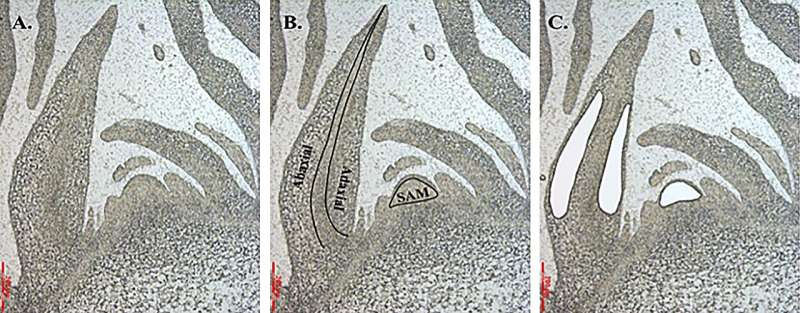LMD of heading Chinese cabbage CC-Z16 shoot apical meristem and surrounding leaf primordium at the rosette stage (six weeks after sowing). (A) Representative transverse section of the SAM and leaf primordium. Targeted meristem (SAM) and mesophyll cells (leaf abaxial/adaxial cells without epidermal cells) before (B) and after (C) LMD. Credit: Horticulture Research (2024). DOI: 10.1093/hr/uhae059
Understanding the genetic mechanisms behind leaf development is crucial for improving crop yields and resilience. In Chinese cabbage, the formation of leafy heads involves complex gene interactions that determine leaf shape and orientation. Despite progress in model plants like Arabidopsis, the molecular basis of these processes in Brassica species remains less clear.
Based on these challenges, it is necessary to conduct in-depth research to uncover the genetic regulation of leaf development in crops like Chinese cabbage.
Researchers from Hebei Agricultural University, in collaboration with Wageningen University & Research, have published an article in Horticulture Research detailing the transcriptomic analysis of Chinese cabbage. The study focuses on the gene expression patterns during leaf initiation, a key phase in the plant's development.
The study delves into the molecular mechanisms driving leaf development in Chinese cabbage, particularly the initiation of leaf primordia and the establishment of adaxial-abaxial polarity. Researchers utilized laser microdissection to isolate cells from the shoot apical meristem (SAM) and leaf primordia, followed by RNA sequencing to profile gene expression.
Key findings include the identification of genes involved in hormone signaling pathways, such as auxin, cytokinin, and gibberellin, which play critical roles in leaf formation.
The study also highlighted the expression of transcription factors like HD-ZIP III, KANADI, and YABBY, essential for adaxial-abaxial polarity establishment. Notably, the gene expression patterns in Chinese cabbage showed similarities and differences compared to model plants like Arabidopsis, reflecting the unique evolutionary path of Brassica species.
The analysis revealed that gene expression in the SAM clustered with the adaxial side of leaf primordia, while the abaxial side aligned with the expanding rosette leaves. This co-expression pattern underscores the intricate regulatory networks governing leaf development. The study provides a comprehensive catalog of differentially expressed genes, offering a foundation for future research on leafy head formation and crop improvement.
Dr. Guusje Bonnema, a co-author from Wageningen University, stated, "This study advances our understanding of the genetic basis of leaf development in Brassica crops. By elucidating the gene expression patterns associated with leaf primordia and polarity, we can better understand the formation of leafy heads in Chinese cabbage, paving the way for targeted breeding strategies to enhance crop performance."
The insights from this study have significant implications for agriculture and crop breeding. Understanding the genetic regulation of leaf development enables breeders to develop Chinese cabbage varieties with optimized leaf shapes and sizes, enhancing yield and quality.
The knowledge of gene expression patterns in leaf development is a valuable resource for future genetic engineering and breeding programs, addressing global food security challenges.
More information: XiaoXue Sun et al, Transcriptomic analyses to summarize gene expression patterns that occur during leaf initiation of Chinese cabbage, Horticulture Research (2024). DOI: 10.1093/hr/uhae059
Journal information: Horticulture Research
Provided by TranSpread
























